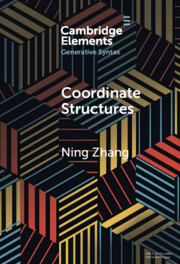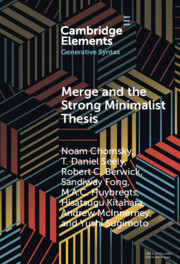Refine search
Actions for selected content:
6584 results in Grammar and Syntax
Chapter Three - Myth 3 You Can’t Write That and Be Smart
-
- Book:
- You Can't Write That
- Published online:
- 09 November 2023
- Print publication:
- 23 November 2023, pp 48-66
-
- Chapter
-
- You have access
- Open access
- HTML
- Export citation
Index
-
- Book:
- You Can't Write That
- Published online:
- 09 November 2023
- Print publication:
- 23 November 2023, pp 224-227
-
- Chapter
-
- You have access
- Open access
- HTML
- Export citation
Chapter Seven - Myth 7 You Can’t Get a Job if You Didn’t Write Well in College
-
- Book:
- You Can't Write That
- Published online:
- 09 November 2023
- Print publication:
- 23 November 2023, pp 126-144
-
- Chapter
-
- You have access
- Open access
- HTML
- Export citation
Chapter Four - Myth 4 You Can’t Write That on the Test
-
- Book:
- You Can't Write That
- Published online:
- 09 November 2023
- Print publication:
- 23 November 2023, pp 67-85
-
- Chapter
-
- You have access
- Open access
- HTML
- Export citation
Chapter One - Myth 1 You Can’t Write That
-
- Book:
- You Can't Write That
- Published online:
- 09 November 2023
- Print publication:
- 23 November 2023, pp 12-28
-
- Chapter
-
- You have access
- Open access
- HTML
- Export citation
Chapter Two - Myth 2 You Can’t Write That in School
-
- Book:
- You Can't Write That
- Published online:
- 09 November 2023
- Print publication:
- 23 November 2023, pp 29-47
-
- Chapter
-
- You have access
- Open access
- HTML
- Export citation
Chapther Five - Myth 5 Chances Are, You Can’t Write
-
- Book:
- You Can't Write That
- Published online:
- 09 November 2023
- Print publication:
- 23 November 2023, pp 86-104
-
- Chapter
-
- You have access
- Open access
- HTML
- Export citation
Notes
-
- Book:
- You Can't Write That
- Published online:
- 09 November 2023
- Print publication:
- 23 November 2023, pp 170-188
-
- Chapter
-
- You have access
- Open access
- HTML
- Export citation
Introduction: When Writing Means Correct Writing
-
- Book:
- You Can't Write That
- Published online:
- 09 November 2023
- Print publication:
- 23 November 2023, pp 1-11
-
- Chapter
-
- You have access
- Open access
- HTML
- Export citation
Chapter Six - Myth 6 You Can’t Write if You Didn’t Write Well in High School
-
- Book:
- You Can't Write That
- Published online:
- 09 November 2023
- Print publication:
- 23 November 2023, pp 105-125
-
- Chapter
-
- You have access
- Open access
- HTML
- Export citation
References
-
- Book:
- You Can't Write That
- Published online:
- 09 November 2023
- Print publication:
- 23 November 2023, pp 189-223
-
- Chapter
-
- You have access
- Open access
- HTML
- Export citation
Afterword
-
- Book:
- You Can't Write That
- Published online:
- 09 November 2023
- Print publication:
- 23 November 2023, pp 168-169
-
- Chapter
-
- You have access
- Open access
- HTML
- Export citation
Figures
-
- Book:
- You Can't Write That
- Published online:
- 09 November 2023
- Print publication:
- 23 November 2023, pp viii-viii
-
- Chapter
-
- You have access
- Open access
- HTML
- Export citation
Copyright page
-
- Book:
- You Can't Write That
- Published online:
- 09 November 2023
- Print publication:
- 23 November 2023, pp iv-iv
-
- Chapter
-
- You have access
- Open access
- HTML
- Export citation
Contents
-
- Book:
- You Can't Write That
- Published online:
- 09 November 2023
- Print publication:
- 23 November 2023, pp vii-vii
-
- Chapter
-
- You have access
- Open access
- HTML
- Export citation
Chapter Eight - Myth 8 You Can’t Write That Because Internet
-
- Book:
- You Can't Write That
- Published online:
- 09 November 2023
- Print publication:
- 23 November 2023, pp 145-160
-
- Chapter
-
- You have access
- Open access
- HTML
- Export citation
Tables
-
- Book:
- You Can't Write That
- Published online:
- 09 November 2023
- Print publication:
- 23 November 2023, pp ix-ix
-
- Chapter
-
- You have access
- Open access
- HTML
- Export citation

Languages of the World
- An Introduction
-
- Published online:
- 21 November 2023
- Print publication:
- 07 December 2023
-
- Textbook
- Export citation

Coordinate Structures
-
- Published online:
- 21 November 2023
- Print publication:
- 14 December 2023
-
- Element
- Export citation

Merge and the Strong Minimalist Thesis
-
- Published online:
- 17 November 2023
- Print publication:
- 14 December 2023
-
- Element
- Export citation
